Bitcoin mining is a process that is integral to the functioning of the cryptocurrency industry. It is a process that involves solving complex mathematical equations, which in turn helps to validate transactions on the blockchain network. The miners are rewarded with newly minted bitcoins for their efforts, which serves as an incentive for them to continue validating transactions. In this article, we will delve deeper into the world of bitcoin mining, how it works, and the role it plays in the cryptocurrency ecosystem.
To understand bitcoin mining, it is important to first understand what the blockchain is. The blockchain is a decentralized digital ledger that records all transactions made using bitcoin. The transactions are grouped into blocks, and each block is connected to the previous block, forming a chain of blocks. This is why it is called a blockchain. The blocks are secured through a process called cryptography, which makes it virtually impossible to alter any transaction recorded on the blockchain.
The mining process begins with a bitcoin transaction. When a transaction is made, it is broadcasted to the network for validation. The transaction is verified by the nodes on the network, which are essentially computers connected to the blockchain. The nodes check if the transaction is valid by looking at the sender’s wallet balance and verifying that they have enough funds to make the transaction. Once the transaction is verified, it is added to the blockchain ledger.
This is where the miners come in. Miners are essentially nodes that perform an additional function. They solve mathematical equations that are designed to validate the transactions on the blockchain. The equations are very complex and require a lot of computational power to solve. The miners use specialized hardware, such as ASICs (Application-Specific Integrated Circuits) and GPUs (Graphics Processing Units), to solve these equations.
When a miner solves an equation, they create a new block that is added to the blockchain. The block contains the validated transaction, along with a record of other recent transactions. The block also contains a unique code called a hash, which is generated from the data in the block. This hash serves as a unique identifier for the block, and it is used to connect the block to the previous block in the blockchain. This is why the blockchain is often referred to as a chain of blocks.
The miners are incentivized to solve these equations because they are rewarded with newly minted bitcoins. The reward for mining a block is currently 6.25 bitcoins, which is approximately $270,000 at the current bitcoin price. However, the reward is halved every 210,000 blocks, which occurs approximately every four years. This is known as the bitcoin halving, and it is designed to limit the supply of new bitcoins entering the market.
The mining process also plays a crucial role in maintaining the security of the blockchain. Because the blockchain is decentralized, there is no central authority that can validate transactions. Instead, the network relies on a consensus mechanism to validate transactions. The miners play a key role in this consensus mechanism. When a miner solves an equation and creates a new block, they broadcast the block to the network for verification. The other nodes on the network then verify the block by checking the hash and the transactions contained in the block. If the majority of the nodes on the network agree that the block is valid, it is added to the blockchain. This ensures that the blockchain is secure and tamper-proof.
However, mining is not without its challenges. The computational power required to solve the equations is very high, which means that the hardware required to mine can be very expensive. The energy consumption required to power the hardware is also very high, which has led to concerns about the environmental impact of bitcoin mining. In addition, the mining process has become increasingly centralized, with a small group of miners controlling the majority of the mining power. This has led to concerns about the security and decentralization of the blockchain.
In conclusion, bitcoin mining is a complex process that is integral to the functioning of the cryptocurrency industry. It involves solving complex mathematical equations to validate transactions on the blockchain network. The miners are rewarded with newly minted bitcoins for their efforts, which serves as an incentive for them to continue validating transactions. The mining process also plays a crucial role in maintaining the security of the blockchain. However, mining is not without its challenges, including the high computational power and energy consumption required, as well as concerns about centralization and environmental impact. Despite these challenges, the mining process remains an essential component of the cryptocurrency industry, and its role is likely to continue to evolve as the industry grows and matures.

























